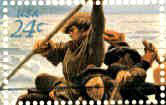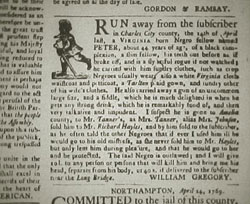Introduction
Contents and Expectations
What is this course?
African American Heritage and Ethnography is a self-paced learning resource or course jointly sponsored by the Park Ethnography Program and the Cultural Resources Stewardship Careers Program. It complements and supplements training courses these programs traditionally sponsor for the education of National Park Service staff, the public and community partners.
Why is this course offered?
The legislated mission of the National Park Service is to: “preserve unimpaired the natural and cultural resources and values of the park system for the enjoyment, education, and inspiration of this and future generations.” The park service explicitly and implicitly defines its mission to refer to the preservation and stewardship of cultural resources that are valued by Americans of all the diverse cultural groups that comprise our nation. Ethnography education and training courses focus on heritage perspectives and preservation of the concerns and values of diverse cultural groups thus contributing to fulfillment of the park service mission.
Who is the course for?
This course is primarily designed to provide National Park Service personnel in cultural resource management, interpretation, and planning with the knowledge, understanding, awareness, and appreciation of African American heritage to enhance their ability to manage and interpret resources, and to better provide for public enjoyment and positive visitor experiences of parks.
The course will also be available to the public and professional audiences currently served by the Park Ethnography Program.
What are the course objectives?
Participation in this course will facilitate the ability of park service staff to:
- Improve their recognition and stewardship of natural and cultural resources valued by African Americans, also called ethnographic resources.
- Identify evidence of African American association with the heritage preserved in each of the National Park sites.
- Interpret African American heritage in the context of the unique perspectives of African Americans, scholarly anthropological information, and defining moments in American social history.
- Identify and reach out to African American individuals and groups that are stakeholders in parks.
Participation in this course by the public and professional audiences will enhance their ability to:
- Participate in conservation, documentation, and interpretation of ethnographic resources traditionally associated with their communities.
- Understand the concepts of ethnographic resources, traditional cultural places, and the applicable laws.
- Participate in the preservation of community and contribute to park planning as informed stakeholders.
- Identify opportunities for collaboration among national and state parks, conservation and heritage organizations, African American communities, cultural anthropologists/ethnographers, and other cultural resource specialists.
Format
In addition to this introductory section, the course is organized into five sections: Key Concepts, Ethnographic Research Center, Content Modules, Heritage Preservation Notes and the Learning Resources Center.
-
Key Concepts explains twelve basics elements necessary for understanding the presentation of material the learning resource modules. The section on Key Concepts addresses the following questions:
- Who are African Americans?
- What is ethnography?
- What is “culture?”
- What are cultural resources?
- What are “ethnographic” cultural resources?
- What is heritage preservation?
- What is stewardship?
- What is the National Park Service Thematic Framework?
-
Ethnographic Research Center explains what ethnographic research is and why it is important. It answers the questions:
- What is ethnographic research?
- Why is ethnographic research conducted?
- Who conducts ethnographic research?
- How is it different from other anthropological research?
- What are its research methodologies?
- How does the park service use ethnographic research?
- Who else uses ethnographic research?
- Content Modules that represent a time period relating African American Heritage to the nation's history and heritage. The Module I African American Nation Founders (1500 - 1789), the first to be presented will be followed by To Build and Preserve the Nation (1790 - 1865), and Lifting as We Climb (1865 - 1965). Each module is divided into subsections:
Historic Contexts and Cultural Heritage.
- The Historic Contexts examines the people and places, social, political, economic events and movements, public policy, laws, wars and social customs of a particular time period that shaped defining moments in history affecting African Americans or affected by them.
- The Cultural Heritage subsection for a particular time-period includes content on the places, sites, and landscapes of significance to African Americans and the cultural practices and patterns of African Americans living in these locations. Cultural Heritage also describes cultural differences between people in different geographic regions, changes in cultural patterns over time and between Africans and their descendants as applicable. The subsection addresses culture change from acculturation to cultural or countercultural resistance.
- The Implications for Heritage Preservation subsection includes content on known ethnographic resources, parks commemorating African Americans, other association(s) of African Americans with parks as well as African American heritage preservation organizations, strategies and strategists. This section discusses identification of ethnographic cultural resources.
- Interactivity Experiences are found throughout the modules. The user has the opportunity for interactivity through three kinds of pop-up screens: In Their Own Words (i.e. quotations from oral or written works by African Americans about their heritage), In the Words of Others (i.e. quotations from primary and secondary sources written by non-African Americans), and Did You Know (i.e. supplemental information about a topic).
- The Learning Resource Center (LRC) is keyed to each section of the course. The LRC provides the user additional information about the section content such as the meaning of words and terms in the Glossary; the sources of information in References; short essays that provide more detailed information about selected content in Further Reading; Links that connect the user to complementary NPS and non-NPS web sites, and the Image Gallery identifying each of the images in the course, providing copyright and source information.
- Learning from the Past Self-Assessment Exercises are located throughout the course. Each of the the ten (10) Learning from the Past Self-Assessments include (3) multiple choice items and one (1) True-False item. After the learner selects an answer for the four items they may check their answers. Correct responses provide the learner with an explanation of why the response is correct. If answers are incorrect the learner may reset the exercise and try to select the correct response.
- Heritage Preservation Notes (HPN) offers participants basic information about heritage preservation laws, the park service programs, including the Park Ethnography Program, that help implement those laws, and how the public may become involved in heritage preservation in parks and beyond. The section provides links to other NPS sites where more detailed HP information is available.
Navigation
All subsections may be accessed directly from the navigation bar or through links found in the unit content.
This distance-learning course is designed to be very user friendly. The top of each page is clearly marked with the course title on the left and, on the right the title of the section the learner is in. The title of the currently active subsection appears in bold above the text and is highlighted in the navigation bar.
There are a number of features that crosscut or are present in all sections. These are:
- A right navigation column with all the section titles. It allows you to quickly jump between and within sections in order to match the content to your current needs.
- A sub-menu on the right navigation column that appears for the current section. The sub-menu provides active links to all the sub-sections, as well as to the sub-sections of the associated LRC.
- Left- and right-arrows at the bottom of each page. These allow you to move through the site from beginning to end, or through an entire section.
- Keywords in the text that are directly linked to an extensive glossary are underlined. In addition, a link to the Glossary is always available from the right navigation column under LRC.
Disclosure
An Editorial Note and Warning: Website visitors should be warned that some of the words, descriptions, and images throughout this course and from other sources as well, are considered racially insensitive by today’s standards. Following the policy recommended by Professor Randall Kennedy, an African American scholar at Harvard Law School, the materials are presented in order to give a true historical picture of earlier social attitudes about Africana and African Americans. Professor Kennedy is a well-known scholar on the use of derogatory language in racial and historical context. He advised the National Park Service, sponsor of this distance-learning course, not to censor the original content of any primary sources we quote. We hope that by providing uncensored text, this course will serve to offer a deeper understanding of the perspectives of African Americans on their heritage and how this heritage is or should be interpreted. Please read Professor Randall Kennedy’s essay A Note on the Word Nigger.
Editorial Method
On numerous occasions in this course, we will quote primary source materials that were written by African Americans and others. Primary source materials in this course will not be corrected or modernized, beyond that imposed by typesetting. This approach, followed by Berlin and his associates, is based on the conviction that readability need not require extensive editorial intervention and modernization compromises the historical value of a document (Berlin and Rowland 1977).
Internet Link Policy
Please note that the NPS Internet policy does not permit links to commercial web sites (URLs that end in .com). Therefore, only links to useful web sites of educational institutions, non-profit organizations, state agencies, and federal agencies are provided.
Credits
This site is produced and maintained in cooperation with the National Conference of State Historic Preservation Officers (NCSHPO).
African American Heritage and Ethnography: A Self-Paced Training Resource may be cited as:
Brown, Audrey and Ericka Hill
- 2006 African American - Heritage and Ethnography: A Self-Paced Training Resource, Ethnography Program, National Park Service, Washington, DC.
http://www.cr.nps.gov/ethnography/aah/AAheritage/index.htm
Layout, Design, and Development:
Amber Young, Consultant, Web Development, Park Museum Management Program, final design, edits, and implementation of this web page.
Matt Burns, and Everett Lindsay, Consultants, Assistant Web Development, Archeology Program / Ethnography Program, designed and implemented the first phase of this web page.
Copyright/Usage Policy
Material on this site, with the exception of the images, may be quoted or reproduced for personal and educational purposes without prior permission, provided appropriate credit is given. Any commercial use of this material is prohibited without prior permission from the National Park Service (NPS) Park Ethnography Program.
When crediting the use of portions of the AAH&E site or materials within that are copyrighted by the NPS (for example, material that is clearly created here), please use:
"Used with permission of The National Park Service, Park Ethnography Program."
This site provides access to materials, licensed or otherwise, for which the copyright is held by owners other than the NPS Park Ethnography Program. Use of these materials and resources is restricted by applicable license agreement and copyright law.
Other requests for use of African American Heritage and Ethnography (AAH&E) materials should be submitted in writing to:
Park Ethnography Program
(Attention: Erma V. Easy)
1846 C Street NW (2276)
Washington DC 20240
Image Requests may be honored for charts, maps, photographs and drawings created by the NPS. Requests for images from other sources should directed to the owners of the image or collections.









